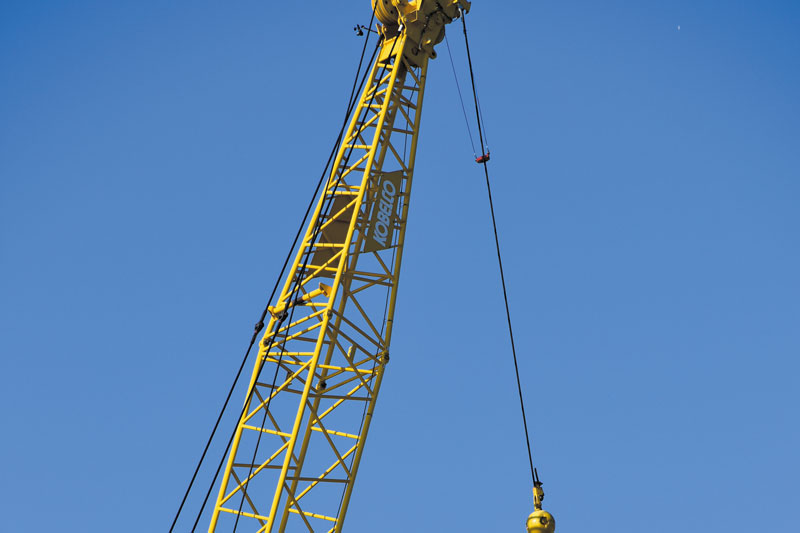
(photo by John Gregory)
Pure Water Program assembly starts soon
By Hoyt Smith
After nearly 12 years of studies, planning and preparation, thePure Water San Diego Program is about to impact Scripps Ranch in a major way.
Construction of a 7.54-mile pipeline will impede local traffic at numerous intersections over the next few years. The project will also affect access to Lake Miramar, including a one-year moratorium on boating there.
It’s all part of Phase 1 of the largest infrastructure undertaking ever in San Diego, totaling 10 different construction projects and more than a billion dollars in expenditures. When the Pure Water San Diego Program is completed and fully operational by 2035, it is targeted to provide one-third of San Diego’s water supply by utilizing proven water purification technology to convert recycled water into safe, high-quality water.
The total estimated construction period for Phase 1 is four years, according to John Stufflebean, assistant director of Pure Water and Technical Services for the Public Utilities Department of the City of San Diego. He said the newly treated water will begin flowing into Miramar Reservoir by March of 2025.
The portion of Phase 1 that will most directly disrupt Scripps Ranch residents is slated to begin in June and may possibly continue into 2024.
“Construction of the pipeline should start in two months and it should last for about two to three years,” Stufflebean said. “Work in the reservoir will probably take more than two years.”
The pipeline route for delivering treated water from the North City Water Reclamation Plant Expansion to the Miramar Reservoir will intersect streets such as Hoyt Park Drive, Scripps Ranch Boulevard, Carroll Canyon Road, Business Park Avenue, Willow Creek Road and Old Grove Road.
“We’re just in the process of awarding the contract,” Stufflebean said. “One of the first things the contractor does is give us their specific schedule. It will be a few weeks before we know when construction will affect these specific streets.”
Community input on Phase 1 of the Pure Water San Diego Program has come from the Scripps Ranch/Miramar Working Group, one of four working groups organized by the City to provide ongoing feedback in order to address and reduce construction issues in various neighborhoods. The Scripps Ranch/Miramar Working Group will assist in disseminating information and sharing residents’ concerns.
“They’ve been very active and have already made dozens of suggestions to reduce the impact of the project,” Stufflebean said.
Once the pipeline carrying the purified water reaches Lake Miramar, it will continue for an additional mile underwater toward the reservoir’s eastern shore.
“A sub-aqueous pipeline will diverge, much like a fishbone, beneath the surface,” Stufflebean said. “There will be about a hundred different ports distributing (the treated water) evenly throughout the reservoir.”
The pipeline will deliver 30 million gallons of purified water per day to Lake Miramar, where it will blend with the City’s imported and local water supplies. It will then be treated once again at the adjacent Miramar Drinking Water Treatment Plant before the reservoir water is distributed to customers. The treatment plant currently provides treated drinking water to an estimated 500,000 customers. The plant produces up to 144 million gallons of treated drinking water per day.
The Phase 1 pipeline project will affect access to Lake Miramar, although the City has consulted with a community working group to mitigate many of the issues that construction will cause. Stufflebean said that there is a plan in place that will eliminate any reduction in parking places.
“New parking will be created to replace any loss of existing parking at the reservoir,” he said. “There will be no changes to on shore activities, no impact along the trails beside the reservoir. The major impact will be to boating. There will be no boating for about a year. It’s a safety issue.”
Stufflebean added that wildlife surrounding Miramar reservoir will not be harmed by introducing treated water into the lake.
“We have done a lot of studies to determine that the surrounding flora and fauna will not be impacted,” he said. “Currently, the reservoir water consists mostly of Colorado River water. Eventually, most of the reservoir water will be cleaner.”
When the Pure Water San Diego Program is complete, it will provide a local, reliable source of extremely pure water that will, along with ongoing conservation efforts, significantly reduce the region’s reliance on Colorado River water.

